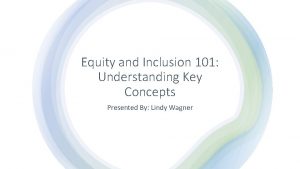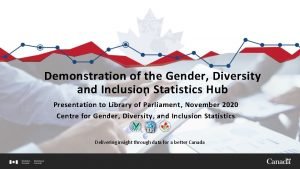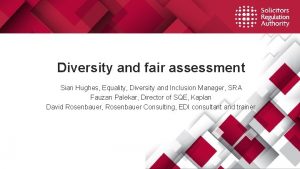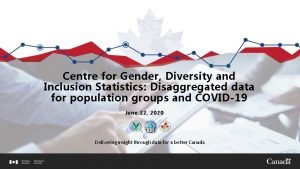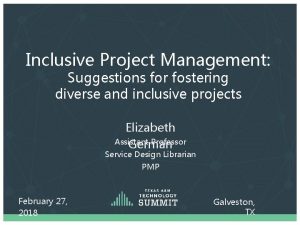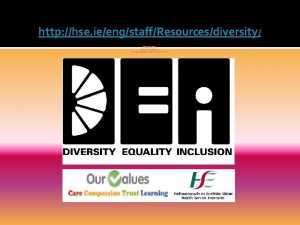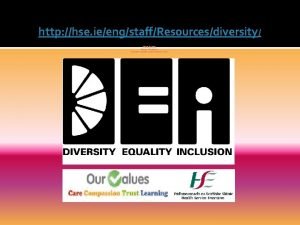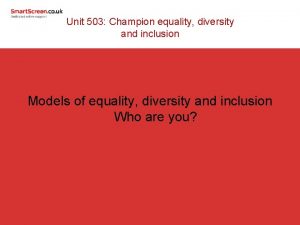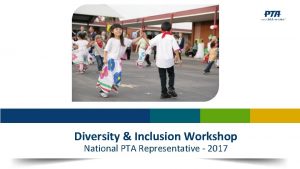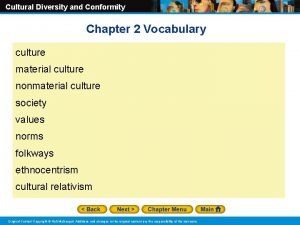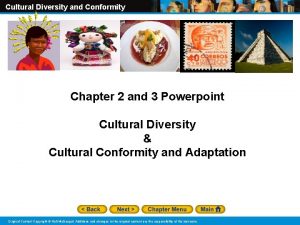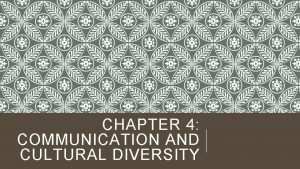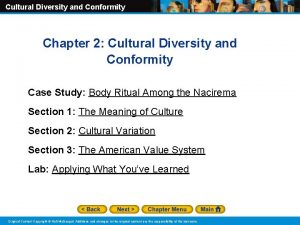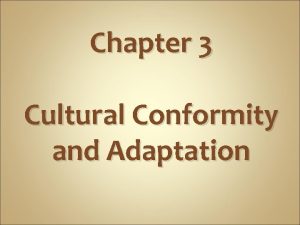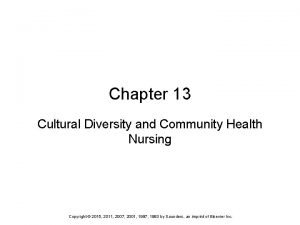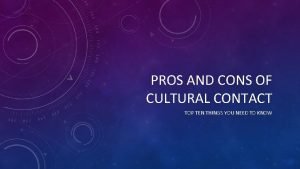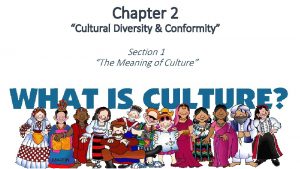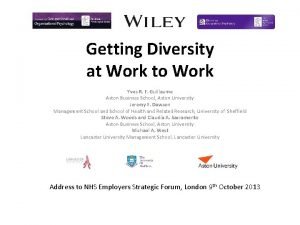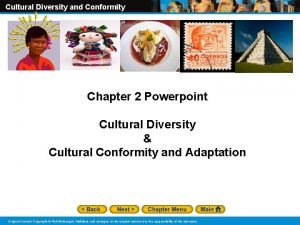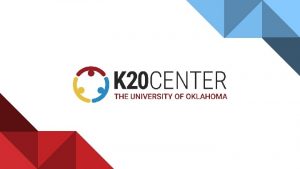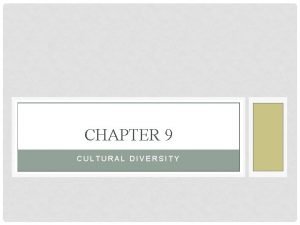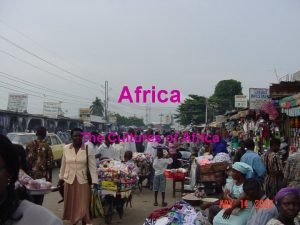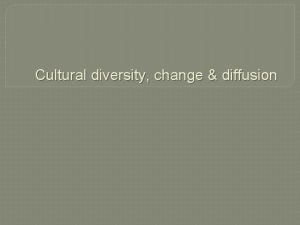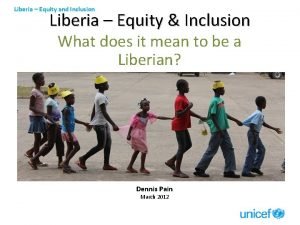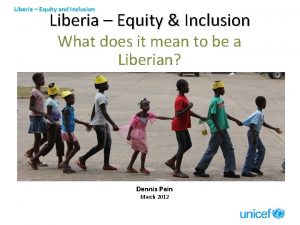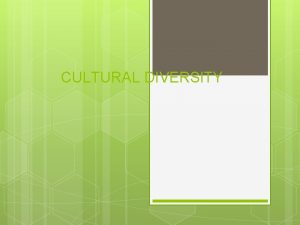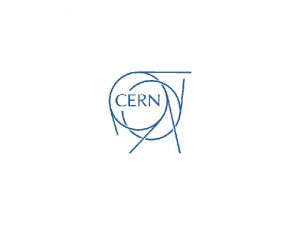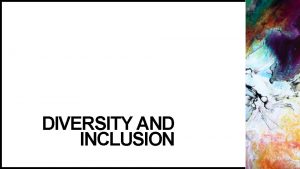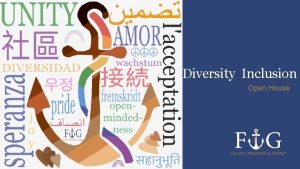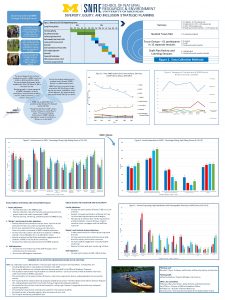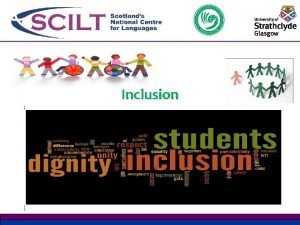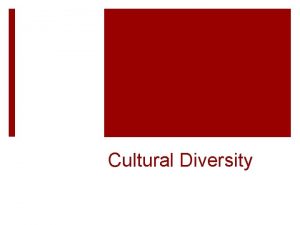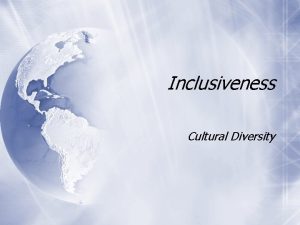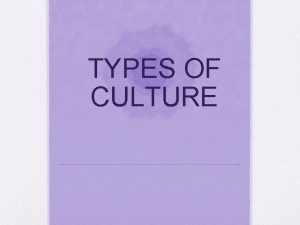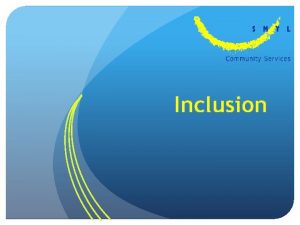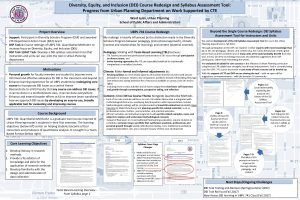Cultural Planning for Diversity Equity and Inclusion Cultivating


































- Slides: 34

Cultural Planning for Diversity, Equity, and Inclusion: Cultivating Change in Communities Dr. Amanda Ashley, Associate Professor, School of Public Service, Boise State University Dr. Carolyn G. Loh, Associate Professor, Wayne State University Karen Bubb, Cultural Planner, City of Boise & Ph. D Student, Boise State University Dr. Leslie Durham, Interim Dean, College of Arts & Sciences, Boise State University October 8 APA ID 2020 ANNUAL CONFERENCE

1. Background 2. What is Cultural Planning? 3. Planning Significance of Project Presentation Overview 4. Project Question 5. Values of Project to Planning Field 6. Methodology 7. Findings 8. Recommendation 9. Questions/Discussion

What is a Cultural Planning? “Cultural planning is a public process in which representatives of a community undertake a comprehensive community assessment and create a plan of implementation for future cultural programming and investment. ” Americans for the Arts ● Topical plan (like transportation) ● Often approved as part of comprehensive/general plan ● No single approach

Cultural Planning is about: • Supporting Artists, Arts Organizations • Planning for Responsible use of Resources • Placemaking – making memorable and meaningful places • Historic Preservation • Fostering Equity • Community Engagement • Economic Development • Small Business Development • Work-force Development • Tourism

This project bridges three content areas: Planning Significance

Project Question How do municipal arts and cultural plans address/include equity, diversity, and inclusion? To Answer: Conducted content analysis of municipal arts and cultural master plans

Value to Planning Field 1) adds applied knowledge on how arts and cultural plans may shape diversity, inclusion, and equity policies and investments 2) gives practitioners and policymakers information on their efforts around diversity, inclusion, and equity so they can be more effective in their efforts 3) identifies strategies for fostering equity in planning practice

Why does Diversity, Equity, and Inclusion (DEI) matter? “APA has made a focused commitment to Equity, Diversity, and Inclusion in all forms, as a means to achieving thriving communities in which everyone has equal opportunity to live a safe, healthy and prosperous life. ”

1. Diversity and inclusion have not always been core planning goals, and although they mostly are now, we still don’t do a great job. Equity in Planning Practice 2. It seems like when they do make an effort, planners largely try to address diversity and inclusion through the public participation process, although this is often not successful for various reasons. 3. Equity is harder to talk about and harder to incorporate in plans because it often involves redistribution and that is politically difficult.

• Methodology • Quantitative Content Analysis Plans selected from a national sample derived from Americans for the Arts database & Internet Content survey of 64 municipal arts and cultural plans from 1998 -2018 What is? How are these cities defining and looking at equity, diversity, and inclusion?

Who is writing municipal cultural plans? Findings • A combination of consultants, municipal staff, steering committees, volunteers, and in a few rare cases, artists (Bellevue, WA, Houston, TX)

Definitions: When used, words such as diversity are infrequently defined (diversity used in 94% of plans, defined by 22%). When equity, inclusion, or diversity is defined, plans had a more comprehensive inclusion of equity principles in the planning process and resulting plan. Findings

Diversity New York City, NY “inclusive of communities representing categories of identity including but not limited to historically underrepresented communities, including individuals from ALAANA racial and/or ethnic groups, people with disabilities, and LGBTQI populations, people with disabilities, all genders, including transgender and gender non-conforming individuals, Indigenous, immigrant, and refugee populations, ESL or non-English language speakers, all ages, including older adults and youth, and low-income New Yorkers” (2017, p. 69) Tacoma, Washington “a social good and the wellspring of free expression. Its support and protection require equitable distribution of public resources, particularly to correct past injustices and balance an excess of commercialization” (2016, p. 46). Santa Clarita, California “encompassing acceptance and respect. It means understanding that each individual is unique, and recognizing our individual differences. These can be along the dimensions of race, ethnicity, gender, sexual orientation, socio-economic status, age, physical abilities, religious beliefs, political beliefs, or other ideologies” (2016, p. 75).

Who is identified as marginalized, underserved? Findings • • • people of color/ethnically or racially diverse young people homeless youth seniors/elders low-income people immigrants and refugees people with disabilities LGBTIQ those in neighborhoods outside the downtown core •

Who, from the public, is participating in the community engagement process and how does this participation represent historically marginalized communities? Findings Those identified as marginalized communities were mentioned to be part of the planning process in only 33% of the plans. • Statistics: Charlotte, NC Cultural Plan notes: “though this planning process was well-publicized and timed to provide ample opportunity for broad-based participation, the white/non-white assessment ratio of response was 81: 19 in a community whose white/nonwhite composition is 49: 51. ” (p. 12) • Zip Code Maps of Respondents: Raleigh, NC

Side-by-Side Survey Responses Minneapolis

Use of Surveys/Targeted Outreach is Most Revealing: Boulder, CO

Use of a Language other than English: Portland, Maine Findings

“Voice” of plans often as “other” than plan authors. represents presumed white majority; “Diversity” is typically positioned Findings Oklahoma City, Oklahoma “The cultural momentum of our City is influencing economic growth, opportunities for tourism, the revitalization of neighborhoods, and a deeper appreciation of ethnic diversity” (2009, p. 3). But no mention in the plan of what ethnic diversity the authors were referring to, nor any indication that people of color were participants in the process.

Strong Equity and Access Prioritized in • Planning Process • Goals & Strategies Dallas Oakland

Mediocre No mention of EDI in: • Community Priorities • Vision Equity and Access Identified in: • Where they have work to do • Under Strategies only in “Strengthen Culture in our Neighborhoods and Communities”

Weak • Done in 2009 • African American, Hispanic and Asian cultures mentioned under Creative Strategy 1: Entice, Attract, Entertain as cultural destination • Diversity used 3 times • 0 use of equity • 0 use of inclusive • No demographics shared (Population 2018 649, 021, 68% white, 19% Latino, 14% Black, 5% Asian, 3% Native American)

Recommendations Make equity a guiding principle that frames the engagement process, data collection, and community conversation. • Equity-based planning processes and practices are increasingly being engaged but are unevenly applied. • How might we identify equity best practices and apply them consistently across comprehensive and topical planning? NYC

Recommendations Engage marginalized populations in the writing of plans. Practitioners need to be more inclusive in the process, content, and tone of arts and cultural plans to ensure that they are inclusive of the many communities within the planning area. Minneapolis

Recommendations Use targeted outreach to engage various populations and show their feedback in the plan.

Recommendations Consider use of languages other than English in outreach materials and the final plan.

Recommendations Collect and provide detailed demographic analysis of planning process participants and the community’s overall population so that place-based diversity is clearly defined and reflected in the final document. Consider using mapping to visualize respondent and community diversity using race and socio-economic data. Minneapolis, MN


Further Research • a survey of arts and cultural planners on planning process and implementation • interview analysis with identified planners to gain more in-depth insight • a comparative case study of different municipal approaches to diversity and inclusion using an arts & culture lens

Further Research Does the impetus to include diversity, equity, and inclusion process or content in a cultural plan come from the commissioning agent (usually the City or Arts Commission), the hired consultants, or the community?

Further Research When there is little about diversity, equity, and inclusion, is that omittance from the commissioning agent, hired consultants, or the community?

Have the diversity initiatives been implemented? Further Research Are there concrete actions or changes that have come from goals and strategies relating to what was outlined in cultural plans such as funding, new or expanded programs, facilities, studies, or partnerships?

Further Research Native Americans are absent from all plans but Boise, ID, Rapid City, South Dakota, and Santa Fe, New Mexico. What are the cultural relationships between Native Americans and municipalities nationally and how might they be more integrated?

Discussion
 Diversity, equity and inclusion 101
Diversity, equity and inclusion 101 Etsu equity and inclusion conference
Etsu equity and inclusion conference Diversity and inclusion scorecard
Diversity and inclusion scorecard Centre for gender diversity and inclusion statistics
Centre for gender diversity and inclusion statistics Diversity and inclusion consulting
Diversity and inclusion consulting Centre for gender diversity and inclusion statistics
Centre for gender diversity and inclusion statistics Korn ferry diversity and inclusion maturity model
Korn ferry diversity and inclusion maturity model Diversity training objectives
Diversity training objectives Dei pulse
Dei pulse Hse diversity equality and inclusion strategy
Hse diversity equality and inclusion strategy Mona talents priority
Mona talents priority Champion equality diversity and inclusion
Champion equality diversity and inclusion Pta diversity and inclusion
Pta diversity and inclusion What is ecosystem biodiversity
What is ecosystem biodiversity Genetic diversity vs species diversity
Genetic diversity vs species diversity Cultural diversity and conformity section 2 answers
Cultural diversity and conformity section 2 answers Cultural diversity and conformity section 1
Cultural diversity and conformity section 1 Chapter 4 communication and cultural diversity
Chapter 4 communication and cultural diversity Examples of countercultures
Examples of countercultures Cultural diversity and conformity chapter test form a
Cultural diversity and conformity chapter test form a Cultural diversity and conformity section 2
Cultural diversity and conformity section 2 Chapter 13 cultural diversity and community health nursing
Chapter 13 cultural diversity and community health nursing Pros and cons of culture
Pros and cons of culture Cultural diversity and conformity section 1
Cultural diversity and conformity section 1 Chapter 4 communication and cultural diversity
Chapter 4 communication and cultural diversity Positive and negative effects of cultural diversity
Positive and negative effects of cultural diversity Cultural diversity and conformity section 1
Cultural diversity and conformity section 1 Salad bowl culture
Salad bowl culture Cultural diversity tcole
Cultural diversity tcole Chapter 9 cultural diversity
Chapter 9 cultural diversity Cultural diversity examples
Cultural diversity examples 2009 delmar cengage learning
2009 delmar cengage learning East africa has great cultural diversity because of its -
East africa has great cultural diversity because of its - Zone of comfort phlebotomy
Zone of comfort phlebotomy Socio-cultural diversity
Socio-cultural diversity
